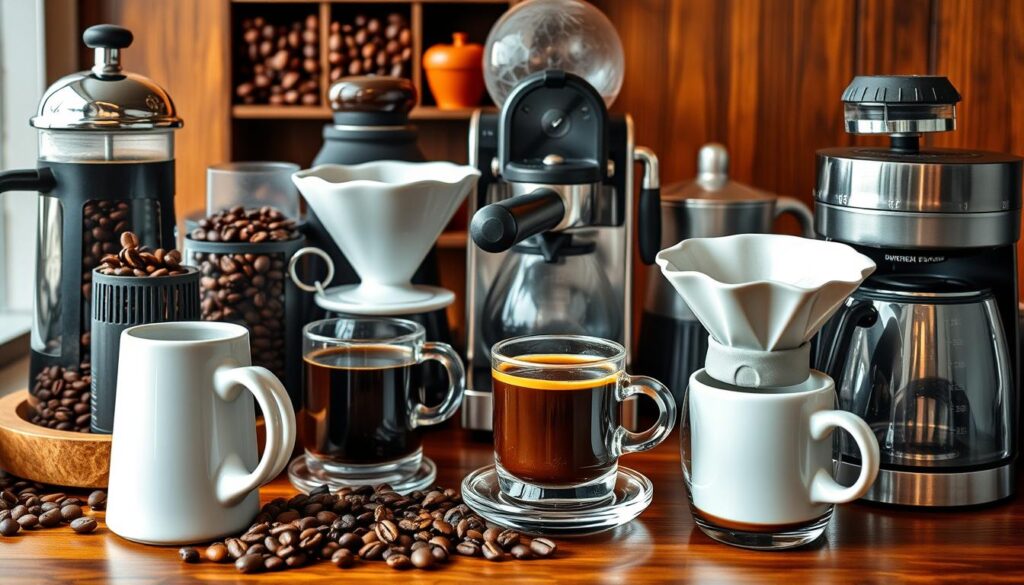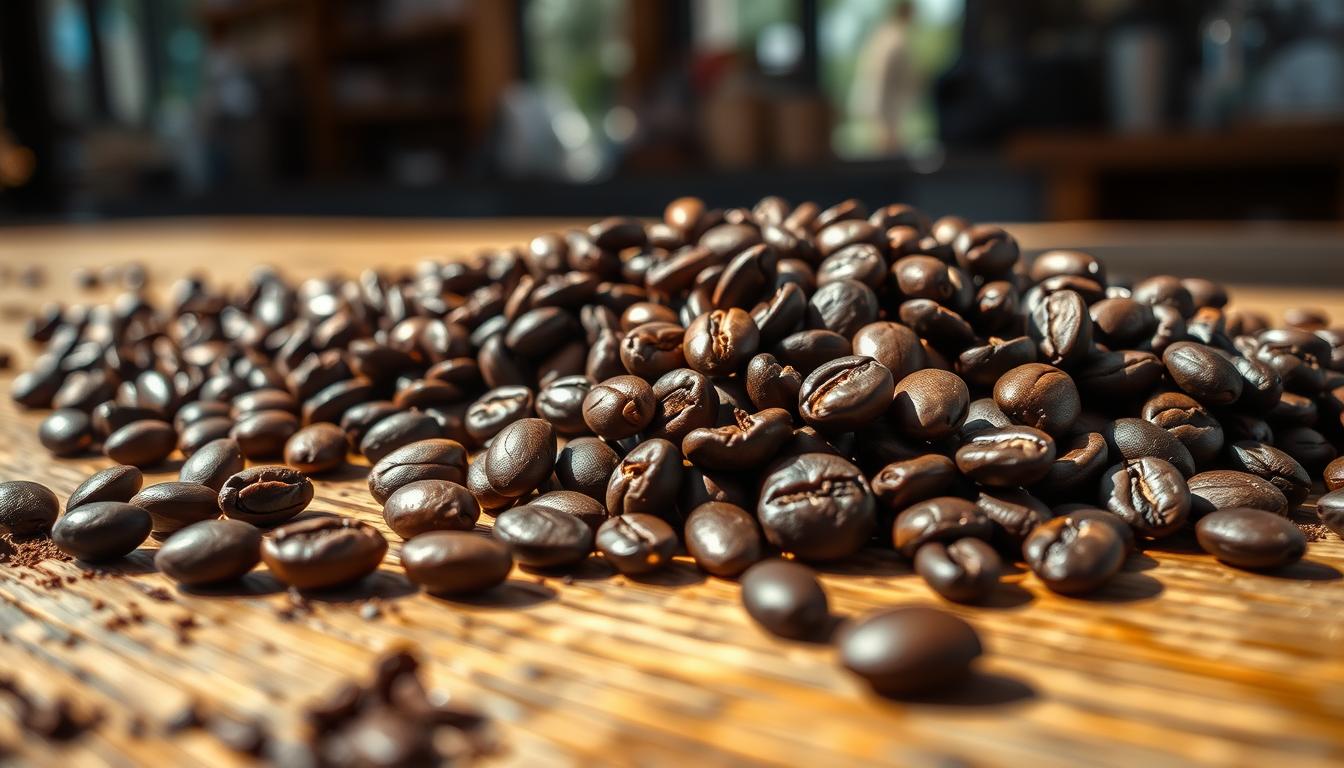Many coffee lovers are now trying out different beans and brewing ways. They often wonder if espresso beans work for drip coffee. The answer is not as simple as it seems.
Key Takeaways
- Espresso beans and regular coffee beans are basically the same, differing only in roast level.
- The main difference lies in the brewing method. Espresso needs high pressure and fine grounds.
- Espresso beans can be used for drip coffee, but you’ll need to adjust the grind and brewing settings.
- Using espresso beans for drip coffee can give you a strong, espresso-like taste.
- Grinding your own espresso beans is best for getting the best flavor in other brewing methods.
Espresso vs Regular Coffee Beans
Many people get confused about espresso beans and regular coffee beans. But, the truth is they are the same beans, just made differently. The main difference is in how they are roasted and brewed.
The Truth About Bean Types
Most coffee beans, for espresso or drip coffee, are Arabica or Robusta. You can use either for both types of coffee. The “espresso” label means they’re roasted and ground for espresso brewing.
Roasting Differences
Espresso beans are roasted darker to balance flavors under pressure. This darker roast makes the coffee sweeter and more balanced. Regular drip coffee beans might be roasted lighter or medium, based on taste.
Common Misconceptions
Some think espresso beans are a special type or blend. But, Arabica and Robusta beans can be used for both espresso and drip coffee. It all comes down to taste and brewing method.
“The difference between espresso and regular coffee lies in the preparation method, not the beans themselves.”
In short, while there are roasting and brewing differences, there’s no real difference between espresso and regular coffee beans. The choice of beans, roast level, and brewing method affect the coffee’s taste, whether it’s espresso or drip.
The Impact of Brewing Methods on Coffee Flavor
The way coffee is brewed greatly affects its taste. From the high-pressure extraction of an espresso machine to the gentle flow of a drip coffee maker, each method highlights different flavors in the coffee beans.
Espresso machines use high pressure, around 9-15 bars, to push hot water through finely ground coffee. This creates a concentrated shot with a thick, creamy crema on top. The intense extraction process makes the coffee’s natural tastes more pronounced and complex.
On the other hand, drip coffee makers use gravity to let hot water flow through the grounds. This results in a more balanced, less intense extraction. The longer brewing time and different pressure levels give it a distinct flavor compared to espresso.
Other brewing techniques, like French press, pour-over, and AeroPress, also offer unique flavors. The grind size, water temperature, and extraction time all affect the coffee’s final taste.
“The difference in flavor between espresso and drip coffee is like the difference between a symphony and a solo instrument – both have their own unique beauty and appeal.”
Understanding how coffee brewing methods impact coffee flavor profiles is key. It helps you enjoy the full taste of your favorite beans, whether it’s a robust espresso or a smooth, balanced drip coffee.

Can You Use Espresso Beans for Drip Coffee?
Yes, you can use espresso beans for drip coffee. But, it’s key to know the flavor and brewing differences. Espresso beans are roasted darker, giving a more intense taste.
Flavor Profile Changes
Espresso beans in drip coffee mean a bolder, richer taste. They often taste more bitter. The dark roast brings out flavors of dark chocolate, cedar, and sweet herbs.
Strength and Concentration
Espresso beans are ground finer and brewed under high pressure. This makes the coffee more concentrated. Using them for drip coffee might make it too strong.
Brewing Time Considerations
The finer grind of espresso beans might change your brewing time. Drip coffee brews faster. Espresso beans might need a bit longer to get the best flavor.
While you can use espresso beans for drip coffee, be aware of the flavor, strength, and brewing time changes. Adjusting ratios and brewing parameters might help find the perfect balance.

“The dark roast of espresso beans provides notes of dark chocolate, cedar, and sweet herbs, which may not align with the typical flavor profile of a drip coffee.”
Grind Size: The Key to Success
The grind size is key when brewing coffee. It’s very important when using espresso beans for drip coffee. Espresso needs a fine grind, while drip coffee prefers a medium grind. Using espresso grind in a drip maker can make the coffee bitter.
To get a great cup of coffee, adjust the grind size for your brewing method. A finer grind means a stronger flavor. A coarser grind makes the coffee smoother. Try different grind sizes to find what you like best.
Grind your beans fresh for the best flavor. Pre-ground coffee loses its freshness and taste. Get a good burr grinder for a consistent grind every time.
“Consistency in grind is key for a great coffee brew. Burr coffee grinders are best for experts and coffee lovers.”
For drip coffee with espresso beans, aim for a medium grind, like granulated sugar. This balances the flavor without making it bitter. The right grind size is all about your taste and the brewing method.
How to Adjust Brewing Parameters for Espresso Beans
Using espresso beans for drip coffee means you’ll need to tweak your brewing settings. You’ll want to adjust the water temperature and the coffee-to-water ratio. These changes will help you get a delicious cup of coffee every time.
Water Temperature Guidelines
The best water temperature for brewing with espresso beans is between 195°F and 205°F. This temperature range brings out the beans’ full flavor, making your coffee rich and balanced.
Coffee-to-Water Ratio
Espresso beans pack a stronger flavor than regular coffee beans. So, you might need to adjust the coffee-to-water ratio. Aim for a ratio of 1:15, or 32 grams (1.1 ounces) of coffee for every 16-ounce cup of water.
Extraction Time Management
Watching the extraction time is key when brewing with espresso beans. The finer grind and higher water temperature can cause over-extraction. This makes your coffee bitter. Keep an eye on the extraction time and adjust it to get the flavor you like.
“The key to brewing the perfect cup of coffee with espresso beans is finding the right balance between water temperature, coffee-to-water ratio, and extraction time. With a little experimentation, you’ll be able to unlock the full flavor of these bold and flavorful beans.”
Taste Differences and What to Expect
Using espresso beans in your drip coffee maker will give you a bolder taste. The coffee will have a fuller body and more bitterness than usual. You might taste dark chocolate or roasted notes, making it a robust cup.
Some people love the bold taste of espresso beans in drip coffee. But, others might find it too strong. The coffee flavor profiles can differ a lot between espresso taste and drip coffee taste. It’s important to try different things to find what you like best.
“The use of espresso beans in a drip coffee maker can result in a richer, more complex cup of coffee, but it may not be to everyone’s liking. The key is to find the right balance that suits your taste buds.”
To make the coffee less bitter and more flavorful, adjust the grind size and brewing settings. This way, you can make a balanced cup that highlights the beans’ unique taste.
Whether to use espresso beans in drip coffee is up to you and your taste. Try out different flavors and find the perfect cup that you enjoy.
Conclusion
Using espresso beans for drip coffee is doable with the right tweaks. It’s all about knowing the differences in roast levels, grind size, and brewing methods. By experimenting, you can find the perfect mix that matches your taste.
Espresso beans can make your drip coffee stronger and more intense. But, it’s really up to what you like. Feel free to try out different coffee styles to find what you enjoy most.
Whether you choose espresso beans or regular drip coffee beans, the quest for the perfect cup never ends. It’s a chance to keep improving your brewing skills and discovering your favorite flavors. Let your taste buds lead the way in this exciting journey.







